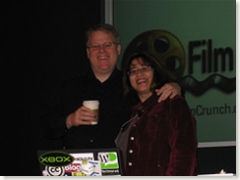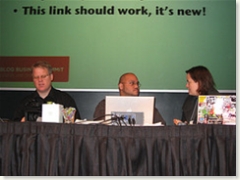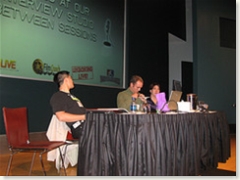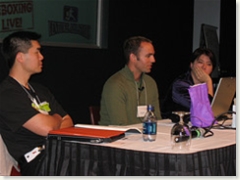Maryam Scoble and some guy she brought with her presented Ten Ways to a Killer Blog. And they should know.
Maryam: Don’t start blogging when people tell you to do it. Do it only when you feel like it.
 Robert: How do you start a blog? Start by reading other blogs. By doing this, you’ll be able to identify styles of writing that you like. And you’ll also figure out whether you will be a good blogger. Because if you read blogs for a few weeks and find that you are not constantly commenting on other blogs, blogging may not be right for you. Blogging is about conversation and if you don’t comment regularly, you’ll probably write a “press release” style blog – and they’re really boring.
Robert: How do you start a blog? Start by reading other blogs. By doing this, you’ll be able to identify styles of writing that you like. And you’ll also figure out whether you will be a good blogger. Because if you read blogs for a few weeks and find that you are not constantly commenting on other blogs, blogging may not be right for you. Blogging is about conversation and if you don’t comment regularly, you’ll probably write a “press release” style blog – and they’re really boring.
Maryam: When you start to blog, you’ll develop friends and online relationships. You’ll learn and you’ll develop a network that will be valuable.
Robert: If you’re trying to build a business audience, become an authority on it. And be generous by sharing your knowledge. And link to others. This will draw people to you.
Maryam: There are two kinds of bloggers: Bloggers who want to make things, shake things and change the world. There are other bloggers who just want to talk to their friends, post their baby pictures, talk about books, and share with friends. But regardless of which type of blogger you are, there are some things you must know to make your blog popular.
Robert: It’s a google world. The first thing most people do when they are using the internet is to go to the search bar. The search bar has become the primary entry point for using the computer.
People who focus their blogs on a single niche seem to do better than people who write generalist blogs. If you understand this, you must pick a niche you can specialize in and develop a unique perspective. This will allow people to find you and to return to you.
Can people still do this or have all the niches been occupied by early bloggers? Mike Arrington and TechCrunch is an example of a late entrant who developed a distinct voice by picking a narrow niche and going even deeper.
 Link to other blogs.
Link to other blogs.
When Robert began to blog at Microsoft, he began to link out. And as he did, people noticed and began to interact with him. As they did this, their comments moderated in tone.
Maryam: Even A listers maintain searches for their name. If you write about them, don’t be surprised if they comment on your blog.
Robert: Anyone can become an A lister with great content. For example, by having an interview with Steve Jobs.
He was challenged on this by voices from the audience. But Maryam came to the rescue.
Maryam: “I think it’s about coming up with consistent stuff. By covering interesting things and saying interesting things on a regular basis. It takes time.”
Robert: “There’s not just one A list. There’s 100,000 A lists. There’s one for every topic.”
Maryam: “There’s no one right way. I write about many different topics. My way is different from Robert’s.”
Admit your mistakes.
Maryam: “This is one of the reasons I didn’t want to blog. I read Robert’s blog and many of the comments were very harsh personal attacks. Because of Robert’s response, he gained credibility.”
Robert: “This is something I’ve learned. Richard Nixon didn’t admit that he’d made a mistake and people just kept piling on. When I make a mistake I try to admit that I’ve done it.”
Write good headlines.
Robert: In a google world, keywords and good headings count. In a world with much greater volume, you have to scan more rather than read deep. So, write good, descriptive headlines. They will stick out of the list. And they’ll be found more easily.
Robert showed the homepage of techmeme to illustrate that someone who writes good headlines will get noticed.
 Use other media.
Use other media.
Robert: TechCrunch is a good example of this. When Michael Arrington started, every post had a graphic. This raised the bar. And today, you need to use a variety of other media – pictures and videos in particular.
Even if you are a text blogger, you can use a visual to stand out. This is why many text bloggers use lists. By breaking a text blog into a list, you can grab attention.
Robert pointed to crayon as an example of a company that is using Second Life to stand out. And GM uses flickr pictures.
Have a voice.
Maryam: Let people see you behind the posts. It will make people want to connect to you.
Get outside the blogosphere.
Maryam: By going to conferences, meeting other people, you will develop stronger relationships. And this still counts with blogging.
Robert: This is where the PR people miss out. They don’t realize that they need to go to conferences and meet people.
Market yourself.
Maryam: Recently, my blog was featured on the Best of MSN. I got 4,000 hits per day as a result of this.
Robert: Put your URL on your business card. It will help people to find you. Also, be creative with your business card. It’s those little touches that will help you.
Search google for Scoble business card tips.
Write well.
Maryam: Before you publish your post, do a spellcheck. Reread to be sure you said what you wanted to say. “Check your state of mind and state of heart” to avoid saying things you will regret.
Robert: Write short paragraphs. Put the most interesting information up top (the journalistic inverted pyramid.)
Expose yourself.
Robert: A lot of corporate types are very reserved about their writing. Every blogger has a knob that reads “safe” on one side and “interesting” on the other side. Don’t stay on the safe side. Spice up your blogs by showing something about yourself. Tell stories. Move the needle to the interesting side and you’ll get a more engaged side.
Help other people blog.
Maryam: Share what you’ve learned and help other people get into the community. That will build the network globally and for yourself as well.
Engage with commenters.
Robert: A lot of corporate ty
pes are skittish about going to other blogs and participating in the conversation. Simply having your own blog is not enough. You need to go to other blogs and comment to become known and to attract new readers to your own blog.
Keep your integrity.
Robert: “Dave Winer would keep telling me this.” You are what you appear to be. Don’t try to fool people or misrepresent yourself.
Thanks to Maryam Scoble and Robert Scoble for an enjoyable, engaging session by two people who really project happiness.
 People who have been in meetings with me will tell you that the first thing I do after I sit down at the table is to pull out my BlackBerry or open my notebook computer and start to take notes.
People who have been in meetings with me will tell you that the first thing I do after I sit down at the table is to pull out my BlackBerry or open my notebook computer and start to take notes.






 I’ve been following the discussion about astroturfing
I’ve been following the discussion about astroturfing  Now, Kami Huyse has published an
Now, Kami Huyse has published an  A hat tip to the
A hat tip to the 

 Shel Holtz
Shel Holtz Jody Humble, regional manager of corporate communication for FedEx Canada, argues that storytelling is an effective way to communicate and shape corporate culture.She opened her presentation with a video narrated by individuals reflecting on how FedEx employees has rallied to help in the wake of Hurricane Katrina’s devastation of New Orleans and Louisiana.“That explains the kind of company we are trying to be.” And the company clearly is doing something right ait ranks number four on Fortune’s list of most admired companies.Key drivers of culture at FedEx include a recognition that “Our product is our people.” Layered onto this is the evolving portfolio of companies (e.g. Kinko’s) and increased competition. Finally, there is a recognition that expectations of the company are changing. For example, in the post-911 world, the company must play a role in ensuring the security of it clients.
Jody Humble, regional manager of corporate communication for FedEx Canada, argues that storytelling is an effective way to communicate and shape corporate culture.She opened her presentation with a video narrated by individuals reflecting on how FedEx employees has rallied to help in the wake of Hurricane Katrina’s devastation of New Orleans and Louisiana.“That explains the kind of company we are trying to be.” And the company clearly is doing something right ait ranks number four on Fortune’s list of most admired companies.Key drivers of culture at FedEx include a recognition that “Our product is our people.” Layered onto this is the evolving portfolio of companies (e.g. Kinko’s) and increased competition. Finally, there is a recognition that expectations of the company are changing. For example, in the post-911 world, the company must play a role in ensuring the security of it clients.